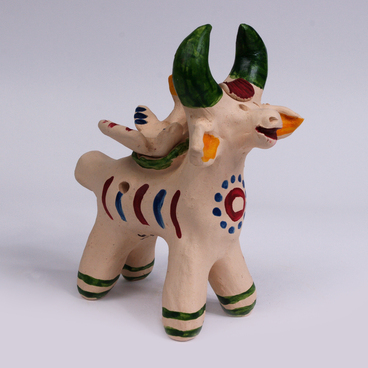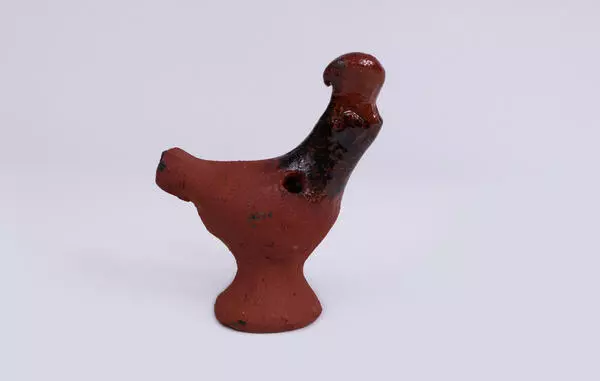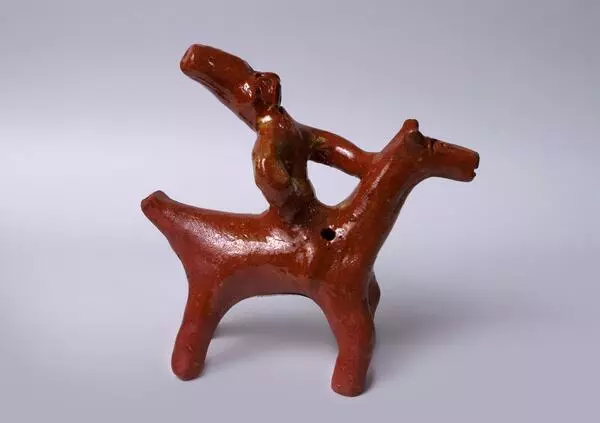The cow whistle was created by the hereditary ceramic master Yury Spesivtsev. He made a tiny clay figurine that can easily fit the palm of your hand. The craftsman decided to make the toy without legs and hooves. The body of the cow is the resonance chamber of the whistle, the small holes on the toy’s sides are the tone holes of the musical instrument.
A small person sits on the cow’s neck. The ‘rider’ grabs hold of the cow’s distinctly protruding horns. The rider’s torso and legs are carefully attached to the cow’s body, they fit perfectly the toy’s shape. The horseman’s whole body is rendered in a very simplistic manner: it has a tiny head and two holes for eyes. The cow’s eyes and nostrils are also marked as holes.
Yury Spesivtsev’s work is distinguished by the unique integrity of the characters and images he creates: the artist models simple yet very expressive toys without any unnecessary details. Most of his works are plain clay toy whistles in different shapes: ducks, roosters, doves with glazed heads and sharp beaks. The “Cow-shaped whistle toy” was also created according to the traditions of Russian folk crafts.
Sudzha toys are made from local red clay. The folk craftswoman Elena Rastorotskaya explained that there are small deposits of pink-white clay within the area of Sudzha, but red clay is usually used for making Sudzha toys. This clay is characterized by high density and is suitable not just for toy-making but also for modeling larger ceramic products.
The local clay toys originated in Sudzha, a town that was founded on the Sudzha River in Kursk Oblast. Sudzha was built as a part of the system of fortifications in 1664, but the lands here had been inhabited long before that: the Cossacks used to live here and protect Russian lands from the Tatar raids. The archaeological remains show that ever since the 3rd and 4th centuries, and then from the 5th to the 7th century, there were large settlements of the Slavs. Sudzha pottery was first mentioned in the 17th century. It reached its peak during the first two decades after the Emancipation Reform, in the late 19th century. Sudzha clay toys were first mentioned in a written record in 1904: that was the time they were demonstrated to the public at the Kursk provincial artisan fair.
A small person sits on the cow’s neck. The ‘rider’ grabs hold of the cow’s distinctly protruding horns. The rider’s torso and legs are carefully attached to the cow’s body, they fit perfectly the toy’s shape. The horseman’s whole body is rendered in a very simplistic manner: it has a tiny head and two holes for eyes. The cow’s eyes and nostrils are also marked as holes.
Yury Spesivtsev’s work is distinguished by the unique integrity of the characters and images he creates: the artist models simple yet very expressive toys without any unnecessary details. Most of his works are plain clay toy whistles in different shapes: ducks, roosters, doves with glazed heads and sharp beaks. The “Cow-shaped whistle toy” was also created according to the traditions of Russian folk crafts.
Sudzha toys are made from local red clay. The folk craftswoman Elena Rastorotskaya explained that there are small deposits of pink-white clay within the area of Sudzha, but red clay is usually used for making Sudzha toys. This clay is characterized by high density and is suitable not just for toy-making but also for modeling larger ceramic products.
The local clay toys originated in Sudzha, a town that was founded on the Sudzha River in Kursk Oblast. Sudzha was built as a part of the system of fortifications in 1664, but the lands here had been inhabited long before that: the Cossacks used to live here and protect Russian lands from the Tatar raids. The archaeological remains show that ever since the 3rd and 4th centuries, and then from the 5th to the 7th century, there were large settlements of the Slavs. Sudzha pottery was first mentioned in the 17th century. It reached its peak during the first two decades after the Emancipation Reform, in the late 19th century. Sudzha clay toys were first mentioned in a written record in 1904: that was the time they were demonstrated to the public at the Kursk provincial artisan fair.



